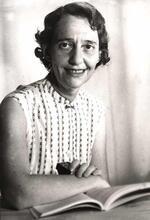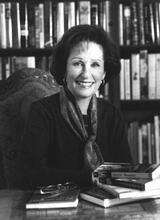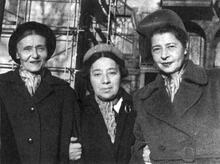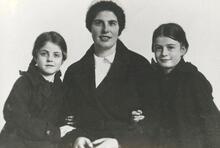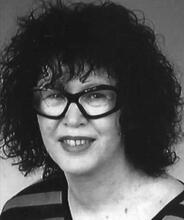Mirra Ginsburg
Ginsburg began her career as a freelance translator of novels, plays, and stories for adults, including Bulgakov’s The Master and Margarita, Dostoyevsky’s Notes from Underground, and the works of Isaac Bashevis Singer. In 1965 she also began translating Russian science fiction. But her children’s books garnered her the most praise, as she translated appealing and intriguing collections of folktales and also wrote original stories for children, ranging from her take on a Slovenian legend, How the Sun Was Brought Back to the Sky in 1975, to The King Who Tried to Fry an Egg on His Head in 1994. Her work has been translated into various languages from Afrikaans to Zulu. Ginsburg also explored the visual arts as a painter, metalworker, and papercutter.
Early Life
Mirra Ginsburg, translator, editor, storyteller, linguist and prolific author of books for children, was born in Bobruysk (Byelorussia) on June 10, 1909, the daughter of Joseph and Bronia (Geier) Ginsburg. She was imaginative and solitary as a child, an avid reader, interested in everything, traits which defined her throughout her long life. Her parents were poor but always concerned with political and cultural matters and Mirra, who was especially close to them, absorbed this early intellectual heritage as well.
Literary Success
The family eventually left Russia, living in Latvia and Canada before settling in the United States. In Russia, Ginsburg had written stories. As she learned English, in Canada as a child and later in the U.S., she began to write again. But to earn a living, she embarked on a career translating Russian literature, including classics and avant-garde writers. Although offered employment as a full-time translator in various organizations, working 9:00–5:00, she preferred the independence of literary translation and often decided what she would translate on issues of principle. She won critical praise for her work on adult novels, stories, anthologies and plays, among them the Master and Margarita (1967) by Mikhail Bulgakov and We (1972) by Yevgeny Ivanovich Zamyatin, important examples of twentieth century Russian literature. Some of her other translations, which often included introductory essays and explanations of the works in the context of Soviet history, were Azef by Roman Goul, A History of Soviet Literature by Vera Alexandrova, The Diary of Nina Kosterina (1968), Dostoyevsky’s Notes from Underground, as well as additional works by Bulgakov, I. B. Singer, Isaac Babel and Mikhail Mikhaylovich Zoshchenko. In 1965, she began editing and translating anthologies, especially in the Russian science fiction genre.
However, Ginsburg’s most outstanding contribution to the field of literature can be found in her work for a younger audience. Drawing on her love and wide knowledge of folklore, she set about editing, adapting and translating into English both Russian folktales and those of other peoples. She once described folk literature as “among the purest and most profound creations humans have been capable of” and many of her children’s works were adapted from or inspired by such tales, poems and songs. Her picture books for small children are often illustrated by noted artists and her best work has a universal appeal, tapping into basic mythological motifs which render them emotionally appealing to readers of any age.
Critics have praised Ginsburg for creating English language folktale collections of stories from Siberia and Central Asia. Many reflect the rich cultural legacy represented by Chinese, Indian, and Persian influences, as well as the Christian, Moslem and Buddist communities. Among these collections are Three Rolls and One Doughnut: Fables from Russia (1970); The Master of the Winds and Other Tales From Siberia (1970); One Trick Too Many: Fox Stories from Russia (1973); The Twelve Clever Brothers and Other Fools: Folk Tales from Russia (1979); and The Kaha Bird: Tales from the Steppes of Central Asia (1971), which includes Tuvan, Tatar, Kazakh, Uygur, Tadzhik, Uzbek, Kirghiz and Turkmenian stories.
Personal Style
In Ginsburg's individual picture books for children, Ginsburg’s goal was to let the original story sing out as it will and her objective was always to bring delight. She uses a wide variety of folk-motifs, including magical objects, animals, heroes, fools, deceptions, and so on, but was always ready and able to dress her old tales in captivating new ways. As a translator, she sought out contemporary Russian children’s literature, finding themes and ideas among newer writers, such as Daniil Kharms, adapting them to her own voice and mastery of language. A number of her tales are of non-Russian origin, including How The Sun Was Brought Back to the Sky (1975) from a Slovenian tale, and the fable The Two Greedy Bears: Adapted from a Hungarian Folktale (1976). A few titles, such as Kitten from One to Ten (1980), a counting book, are Ginsburg’s original creations.
Among Ginsburg's major works are Four Brave Sailors (1987), The Chinese Mirror 1988), The King Who Tried to Fry An Egg on His Head (1994), Asleep, Asleep (1992) and The Old Man and His Birds (1994). Many of her books were also published in England and translated into various languages including Afrikaans, Chinese, Danish, Japanese, Portuguese, Swedish and Zulu.
Other Interests
Bohemian and fiercely individualistic, Ginsburg was intrigued by every kind of artistry. She herself painted, did metalwork, made jewelry and did intricate papercuts. Until her last years, she often entertained widely diverse gatherings of creative people at her home and took full advantage of New York’s theater, especially Yiddish and Asian theater, as well as ballet and concerts. Ginsburg didn’t travel much but she once flew on the Concorde to visit friends in France, for she had friends all over the world who corresponded with her and visited her when in New York. Her childlike openness and curiosity extended to every nuance of life; her opinions were uncompromising.
A member of the American Literary Translators Association, Authors Guild, Authors League of America and PEN, Mirra Ginsburg died in New York City on December 26, 2000.
Awards
- National Translation Grant, 1967.
- Lewis Carroll Shelf Award for translation of The Diary of Nina Kosterina, 1972.
- Guggenheim Fellowship (1975–76).
Selected Works by Mirra Ginsburg
The Lazies: Tales of the Peoples of Russia (1973).
The Night It Rained Pancakes (1979).
Ookie-Spooky (1979).
Where Does the Sun Go At Night? (1981).
The Sun’s Asleep Behind the Hill (1982).
Clay Boy and the Little White Goat with the Golden Horns (1997).
Contemporary Authors New Revision Series, Gale Research, Vols. 11 (1984), 28 (1990), 54 (1997).
Children’s Literature Review, Gale, Vol. 45 (1998).
Major Authors and Illustrators for Children and Young Adults, First Supplement, Gale (1993).
Something About the Author, Gale Research, Vol. 6 (1974); Vol. 92 (1997): 72–77.





